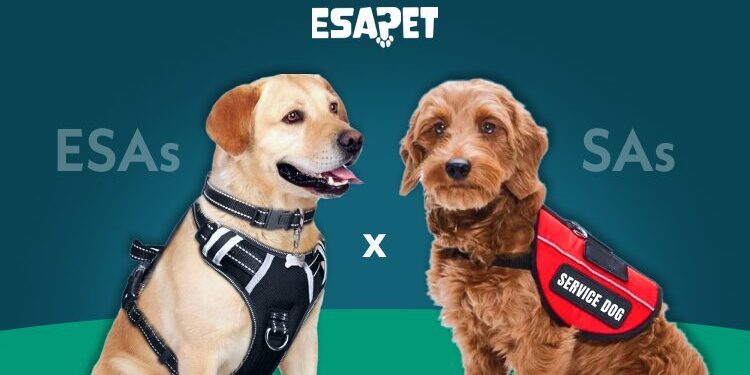ESAs vs Service Animals: Everything About Assistance Animals in 2026

If you’ve ever wondered about the difference between an emotional support animal (ESA) and a service animal, you’re not alone. These two types of support animals often get confused, but they serve very different purposes and come with very different legal rights.
In this guide, you’ll learn exactly what makes an ESA different from a service animal, how the law protects each, and what you need to know if you’re considering getting one. From housing rights to public access and even travel rules, we’ll break down the essentials so you can clearly understand your rights—and your animal’s.
Legal Definition of Assistance Animals
Assistance animals are animals that assist an individual with a disability. Emotional Support Animals (ESAs) and Psychiatric Service Dogs (PSDs) are considered assistance animals. These animals perform specific tasks related to the handler’s disability. They get certain legal rights under federal law when their handlers provide proof of their status, such as PSD Letters or ESA Letters.
The Fair Housing Act (FHA) protects service animals from housing discrimination. The Air Carrier Access Act (ACAA) grants them air travel rights. And they are also given the right to access public facilities under the ADA.
Many people consider Therapy and Companion animals assistance animals because they provide emotional support to people with mental health conditions. However, these animals don’t have the same rights under the ADA, FHA, and ACAA and don’t have the same legal protection.
What is an ESA?

An Emotional Support Animal (ESA) is an animal that alleviates symptoms of mental health conditions like anxiety, depression, or PTSD through companionship and emotional stability.
To qualify for an ESA, a person must have a verified mental or emotional disability, and obtain a letter from a licensed mental health professional confirming the need for the animal. ESAs are legally protected in housing under the Fair Housing Act (FHA), but not in public places under the ADA.
Is an ESA a service animal?
No emotional support animals (ESAs) are not considered service animals because ESAs do not receive specialized task-based training to assist with a person’s disability. ESAs provide emotional comfort and companionship, their value lies in the support they offer simply through their presence. Because of this distinction, ESAs are not granted the same legal protections or public access rights as service animals under laws such as the Americans with Disabilities Act (ADA).
Types of Emotional Support Animals
There is no defined rule regarding which species can be considered an ESA. Any domesticated animal can be an emotional support animal regardless of its age and type. Here’s a list of some of the most common emotional support animals:
- Dogs: An emotional support dog can be a great companion. They provide emotional stability and comfort with their furry touch and affection.
- Cats: Many people prefer cats as their ESAs because of their soothing capabilities and calming presence. Cats are also low-maintenance care. Their furry touch can provide happiness and ease anxiety.
- Rabbits: These little buddies also make for great ESAs with their joyful and playful behavior. Rabbits are a great choice for individuals with small living spaces.
- Birds: Birds offer unique companionship through their soothing vocal interaction. They can help enhance social interaction skills and help deal with loneliness. Common bird species that make for great ESAs include parrots, cockatiels, and parakeets.
What is a Service Animal?

A service animal is a dog specifically trained to perform tasks that directly assist a person with a disability, as defined under Title II and Title III of the ADA. These tasks may include guiding individuals who are blind, alerting someone with epilepsy before a seizure, or retrieving medication.
The ADA demands reasonable accommodation protections that grant service dogs the right to accompany their handlers in most public places, including stores, restaurants, and public transportation.
In limited cases, miniature horses may also be recognized as service animals under the ADA, but dogs remain the primary and most widely accepted type. Although the ADA previously recognized miniature horses as service animals under certain circumstances, regulatory updates and case law have significantly limited their acceptance due to concerns about their size, behavior, and suitability for public access.
Service dogs can perform different tasks depending on their training. These include:
- Assist an individual with visual impairment in safely crossing roads and navigating obstacles
- Alerting people who are deaf to important sounds like doorbells and alarms
- Open and close doors and push elevator buttons
- Provide deep pressure therapy (DPT) during panic and anxiety attacks
- Retrieve dropped items
- Detect and alert to drops in blood sugar
- Assist individuals during or after a seizure
Service animals are considered working animals under the ADA (Americans with Disabilities Act). They have certain rights under the federal law. They have rights to housing accommodation under FHA. Landlords have to accommodate these dogs without extra fees.
Air travel rights under the ACAA allow service dogs to travel with their owners in the cabin without any additional fees. Service animals also have public access rights under the ADA.
Recognized Species for Service Animals
According to ADA, only dogs can be service animals. However, miniature horses can sometimes be considered service animals, depending on their training. Here is the list of the most popular dog breeds trained to be a service animal:
 | Labrador Retriever |
 | Golden Retriever |
 | Bernese Mountain Dog |
 | German Shepherd |
 | Poodle |
 | Cavalier King Charles Spaniel |
Get your Official ESA Letter Consultation from a licensed therapist.
Get ESA Letter NowTypes of Service Animals and Their Roles
There are different types of service animals depending on the type of tasks they can perform. Here’s a list of different types of service animals:
Service animals are specially trained to assist individuals with various disabilities. Each type fulfills a unique role tailored to specific needs. Here’s an overview of common types of service animals and the support they provide:
These dogs are trained to help blind individuals and people with significant visual impairments. They help their handlers cross streets or roads safely and navigate obstacles.
These dogs assist people with hearing disabilities. These include deafness or difficulty in hearing. They alert their handlers to sounds like alarms and doorbells.
These dogs perform various tasks to help people with physical disabilities. These tasks can include pushing elevator buttons, opening doors, retrieving items, and more.
PSDs are trained to assist people with mental health conditions such as depression and anxiety. They perform different tasks to help mitigate psychiatric episodes.
These dogs can sense blood sugar levels. They are trained to alert their handlers to drops or spikes in blood sugar.
These dogs can detect specific allergens in the environment. These include allergens like gluten or peanuts that can cause severe allergic reactions.
Get your Official PSD Letter Consultation from a licensed therapist.
Get PSD Letter NowWhat are the Differences Between Emotional Support Animals and Service Animals
The primary difference between Emotional Support Animals (ESAs) and Service Animals lies in their purpose, training, and legal protections.
Emotional Support Animals provide comfort and companionship that can help ease symptoms of mental or emotional conditions. They do not undergo task-specific training, and their supportive role is based on their presence rather than learned skills.
In contrast, Service Animals undergo extensive, specialized training to carry out distinct tasks that directly assist individuals with physical, sensory, psychiatric, intellectual, or other disabilities. These tasks may include guiding people who are blind, alerting individuals with hearing impairments, interrupting seizures, or reminding handlers to take medication.
Because of this rigorous training and their essential role in supporting individuals with disabilities, Service Animals are granted broad legal protections under laws such as the Americans with Disabilities Act (ADA), which ensures access to most public spaces. ESAs, however, have more limited rights—primarily related to housing under the Fair Housing Act (FHA) and, in some cases, air travel accommodations, though regulations in these areas continue to evolve.
Key Differences Between ESA and Service Animals
Understanding the key differences between ESA and Service Animals is important for knowing your rights and the roles each type of animal plays in supporting individuals with disabilities.
| Aspect | Emotional Support Animals (ESA) | Service Animals (SA) |
|---|---|---|
| Legal Definition | Animals that provide emotional comfort to individuals with a mental health condition | Dogs trained to perform tasks for a person with a disability |
| Training Requirements | No specialized training required | Must be individually trained to perform specific tasks |
| Public Access Rights | Not guaranteed; subject to business or property owner discretion | Full access under the ADA to all public spaces |
| Allowed Species | Dogs, cats, rabbits, birds, and other domesticated animals | Only dogs (and occasionally miniature horses) recognized by the ADA |
| Housing Protections | Protected under the Fair Housing Act (FHA) | Also protected under the FHA |
| Air Travel (Post-2021) | Considered pets; airlines may deny access or charge fees | Allowed in-cabin with no pet fees |
| Documentation | ESA letter from a licensed mental health professional | No letter required; handlers may be asked two specific ADA-compliant questions |
| Task Performance | Does not perform trained tasks | Performs trained tasks related to a person’s disability |
Get your Official ESA Letter Consultation from a licensed therapist.
Get ESA Letter NowEmotional Support Animal Laws vs Service Animal Laws
The legal differences between Emotional Support Animals (ESAs) and Service Animals come down to how each is defined and protected: service animals have broad legal rights under the ADA, while ESAs are more limited, with protections mainly in housing.
Emotional Support Animals (ESAs) provide comfort and companionship to individuals with mental health conditions, but they do not undergo specialized training to perform tasks. Because of this, their legal protections are limited.
ESAs are primarily covered under the Fair Housing Act (FHA), which requires landlords to make reasonable accommodations for tenants with ESAs, even in housing where pets are otherwise restricted or prohibited.
However, ESAs do not have rights to enter public spaces such as restaurants, stores, or airplanes.
Service Animals, by contrast, are specifically trained to perform tasks that directly assist individuals with disabilities. They are protected under the Americans with Disabilities Act (ADA), which grants them broad public access rights.
This means people with service animals can bring them into nearly all public spaces, including restaurants, retail stores, public transportation, and airplanes (in-cabin).
Understanding these distinct legal protections highlights why ESAs and service animals cannot be treated the same under the law. Check the key differences outlined below.
Get your Official PSD Letter Consultation from a licensed therapist.
Get PSD Letter Now
Emotional Support Animal Legal Rights vs Service Animal Legal Rights
| Feature | Service Dog | Emotional Support Animal |
|---|---|---|
| Primary Role | Performs specific tasks related to a disability | Provides comfort and support |
| Training | Task-specific, individualized training required | No special training required |
| Public Access (ADA) | Full access to most public spaces | No public access rights under ADA |
| Defined By | The tasks performed | The emotional benefit provided |
| Public Behavior Requirement | Must be well-behaved and controlled | No formal standards required |
ESA Tenant Rights vs Service Animal Tenant Rights: Housing Protections

Understanding Housing Denials: ESA vs. Service Animals
When it comes to housing, Emotional Support Animals (ESAs) and Service Animals are treated very differently under the law. Knowing these distinctions helps explain why an ESA may face limitations that a Service Animal would not.
What Can Landlords Ask For?
If the need for an Emotional Support Animal (ESA) or Service Animal (SA) is not obvious, landlords may legally request:
- Confirmation that the tenant has a qualifying disability.
- An explanation of how the animal helps mitigate symptoms of that disability.
- Documentation from a licensed healthcare provider familiar with the tenant’s condition.
However, landlords cannot:
- Ask about the specific diagnosis or request access to medical records.
- Automatically reject documentation they deem “inconvenient” (e.g., online letters), although they may request more reliable information if the documentation appears suspicious.
When Can a Landlord Deny an ESA or Service Animal Request?
A landlord may lawfully deny a request if:
- The animal poses a direct threat to the health or safety of others that cannot be reduced through reasonable accommodation.
- The animal would cause significant property damage.
- The request would impose an undue financial or administrative burden on the housing provider.
- Allowing the animal would fundamentally alter the nature of the housing services provided.
Note: These denials must be based on specific and credible evidence, not assumptions or stereotypes.
Can a Landlord Be Penalized for Unlawfully Denying an ESA or Service Animal?
Yes. Under the Fair Housing Act (FHA), unjustified denial of a valid request for an ESA or Service Animal can result in civil penalties and other legal consequences at both federal and state levels.
Legal Basis: The Fair Housing Act (FHA)
The FHA requires housing providers to offer reasonable accommodations for individuals with disabilities. This includes allowing ESAs or Service Animals in “no-pet” housing when:
- The individual has a mental or emotional disability that substantially limits one or more major life activities.
- The animal provides support that alleviates at least one identified symptom or effect of the disability.
Penalties for Unlawful Denial (Federal Level – HUD)
If a landlord unlawfully denies a valid request:
- The tenant may file a complaint with the U.S. Department of Housing and Urban Development (HUD).
- HUD may open an investigation and, if necessary, take enforcement actions.
Emotional Support Animal Legal vs Service Animal: Housing Protections Comparison
| Aspect | Emotional Support Animals (ESA) | Service Animals (SA) |
|---|---|---|
| Legal Protection | Protected under FHA as an assistance animal | Protected under FHA as an assistance animal |
| No-Pet Housing | Must be accommodated | Must be accommodated |
| Pet Fees/Deposits | Not allowed | Not allowed |
| Responsibility for Damage | Tenant is responsible for any damage | Tenant is responsible for any damage |
| Documentation | May be required (letter from licensed provider) | May be required (depending on housing provider’s request) |
| Therapeutic Relationship | Some states require proof of provider-patient relationship (e.g., CA) | Not typically applicable |
| Grounds for Denial | Direct threat, undue burden, or substantial damage | Same as ESA |
Public Access Rights for ESA and Service Animals
Access rights for animals that assist individuals with disabilities differ significantly between Service Animals (SAs) and Emotional Support Animals (ESAs). It’s important to understand these distinctions to know where each type of animal is legally permitted and what obligations businesses and public entities have toward them.
Service Animals (SAs) are granted broad access rights under the Americans with Disabilities Act (ADA). They are allowed in virtually all places where the public is permitted, including stores, restaurants, public transportation, and schools.
They cannot be charged fees for entry, although the owner may be held responsible for any damage caused by the animal.
Get your Official PSD Letter Consultation from a licensed therapist.
Get PSD Letter NowWhen verifying the legitimacy of a service animal, businesses may ask only two questions:
- Is the animal required because of a disability?
- What specific work or task has the animal been trained to perform?
In contrast, Emotional Support Animals (ESAs) do not have the same legal protections for public access. Their presence is determined solely by the discretion of the property or business owner. ESAs may be refused entry into many public places such as restaurants, stores, or public transit without legal penalty to the business.
Public Access Rights for ESA and Service Animals: Comparison
| Aspect | Emotional Support Animals (ESA) | Service Animals (SA) |
|---|---|---|
| Access to Public Places | Not guaranteed—subject to business/property owner discretion | Guaranteed under ADA |
| Examples of Access | May be restricted from stores, restaurants, transportation, etc. | Allowed in public spaces like restaurants, schools, transit, etc. |
| Travel (Post-2021) | Considered pets under DOT rules; not allowed free air travel | Still allowed on planes with no pet fee |
| Planning Considerations | Must verify in advance if animals are allowed | No need—public access is protected by law |
Identification & Misrepresentation of ESAs and Service Animals (SAs)
Proper identification of Emotional Support Animals (ESAs) and Service Animals (SAs) is crucial for ensuring legitimate access rights and preventing abuse of protections.
Identification of Service Animals (SAs):
- Typically, service dogs do not require special identification, certification, or uniforms by law.
- However, many handlers use vests, badges, or IDs to signal the animal’s status and ease access, though these are not legally mandated.
- Airlines and businesses may ask if the animal is a service animal and what tasks it performs, but cannot demand proof or documentation under the ADA.
Identification of Emotional Support Animals (ESAs):
- ESAs require a valid ESA letter from a licensed mental health professional stating the need for the animal due to a mental or emotional disability.
- Unlike service animals, ESAs do not require task training.
- Since January 2021, airlines no longer recognize ESAs as service animals, so the ESA letter may not grant access or fee waivers in travel contexts, but landlords still may require such documentation for housing accommodations.
Misrepresentation Issues:
- Misrepresentation occurs when individuals falsely claim a pet is an ESA or service animal to bypass pet fees, restrictions, or no-pet policies. This can undermine protections for people who genuinely need these animals.
- It is important for individuals to use proper channels to obtain legitimate ESA letters and ensure their service animals are trained and used appropriately.
- Due to increased abuse, many airlines and landlords have tightened documentation requirements, and some jurisdictions impose fines or penalties for fraudulent ESA or service animal claims.
Penalties for Misrepresentation of ESAs and Service Animals in Different States
Penalties for misrepresenting an Emotional Support Animal (ESA) or Service Animal can vary depending on the state or federal context. Some states treat it as a misdemeanor with fines or even jail time, while federal regulations may impose additional penalties in specific settings, such as air travel.
Examples include:
- Arizona: It is a misdemeanor to falsely represent an animal as a service animal or emotional support animal. Violators can face fines up to $500.
- Minnesota: Misrepresenting an animal as a service animal or ESA is a misdemeanor offense punishable by fines up to $1,000 and possible imprisonment for up to 90 days.
- California: Falsely claiming an animal as a service animal can lead to misdemeanor charges, fines up to $1,000, and community service.
- New York: Fraudulent representation of an ESA or service animal can result in fines and potential civil penalties under local housing laws.
- Federal Airlines: The U.S. Department of Transportation may impose fines on passengers who misrepresent ESAs or service animals during air travel, with penalties reaching several thousand dollars.
These laws aim to protect the rights of individuals with legitimate service animals and ESAs, while discouraging fraudulent claims that undermine those protections.
Misrepresentation of ESA and SA Summary
| Aspect | Emotional Support Animals (ESA) | Service Animals (SA) |
|---|---|---|
| ID/Vest Requirement | Not required legally | Not required legally |
| Optional Use | Many owners choose vests for clarity | Same |
| Misrepresentation | Illegal and unethical; punishable in some states | Same |
Flying with ESA vs Service animal
Flying with ESA vs Service Animal requires understanding important regulatory differences. Under the revised guidelines:
- Emotional Support Animals (ESAs) are no longer recognized as service animals. Airlines are permitted to treat ESAs as regular pets, meaning they can charge pet fees and enforce restrictions on size, species, and carrier types.
- Service Animals (SAs), primarily dogs trained to perform specific tasks for individuals with disabilities, must be allowed in the cabin without additional fees. While dogs are the only animals officially recognized as service animals under DOT rules, miniature horses may also be accommodated. Other animals are considered on a case-by-case basis
Understanding these distinctions helps travelers prepare properly and avoid unexpected fees or complications when flying with their animal companions.
Flying with ESA vs Service animal: Comparison
| Feature | Service Animals (SA) | Emotional Support Animals (ESA) |
|---|---|---|
| Allowed in cabin | ✅ Yes (must fit at passenger’s feet or lap) | ❌ No (not required by law) |
| Airlines must accept | ✅ Yes (protected under ADA) | ❌ No (treated as pets by most airlines) |
| Advance notice/paperwork | ✅ DOT form may be required | ✅ Follows pet policy (may require forms, health certificates) |
| Fees | ❌ No pet fee allowed | ✅ Pet fees usually apply |
| Breed restrictions | 🚫 Not allowed – airlines may not ban based on breed alone (unless due to safety or behavior) | ✅ Allowed – airlines can restrict certain breeds (e.g., pit bulls, brachycephalic dogs, Persian cats, etc.) |
Important Notes on Breed Restrictions
Service Animals (SA):
- Airlines cannot deny a dog solely based on breed if it is a legitimate service animal.
- However, they can deny boarding based on specific behavior, such as aggression or lack of control.
Emotional Support Animals (ESA):
- Since ESAs are no longer protected under the Air Carrier Access Act (ACAA), airlines have full discretion to enforce:
- Breed bans (e.g., pit bulls, rottweilers, dobermans)
- Brachycephalic breed bans (e.g., bulldogs, pugs, Persian cats) due to respiratory issues during flights
- Species restrictions (e.g., rabbits, birds, reptiles)
Get your Official PSD Letter Consultation from a licensed therapist.
Get PSD Letter NowESA training vs Service Dog training
Understanding the differences in training requirements and tasks performed by Emotional Support Animals (ESAs) and Service Dogs is key to recognizing their distinct roles and legal protections. While both provide important support to individuals, the nature and extent of their training and duties vary significantly.
Service Dogs undergo specialized, task-specific training to assist individuals with disabilities. These dogs are trained to perform concrete actions that mitigate their handler’s disability, such as guiding the visually impaired, alerting to seizures, or retrieving items. Because of this, they receive legal protections under laws like the ADA, allowing them broad public access.
On the other hand, Emotional Support Animals (ESAs) provide comfort and emotional relief simply through their presence. They do not require specialized training or to perform specific tasks related to a disability. Their primary role is to alleviate symptoms of emotional or psychological conditions by offering companionship, which means they do not receive the same legal rights as service animals.
| Aspect | Emotional Support Animals (ESA) | Service Dogs (SD) |
|---|---|---|
| Training Required | No specialized or task-specific training required | Extensive training focused on specific disability-related tasks |
| Tasks Performed | Provide emotional comfort and companionship | Perform tasks such as guiding, alerting, retrieving, or mitigating a disability |
| Legal Recognition | Not recognized as service animals; limited legal protections | Recognized as service animals with full ADA protections |
| Behavior Standards | Expected to be well-behaved but no formal training mandate | Must be well-trained, controlled, and reliable in public settings |
| Examples of Tasks | N/A (no task requirement) | Guiding visually impaired, alerting to medical events, providing mobility assistance |
What animals can be ESA and service animals?
The types of animals recognized as Emotional Support Animals (ESAs) and Service Animals (SAs) differ due to their distinct roles and legal definitions.
Service Animals are strictly defined by law, primarily as dogs trained to perform specific tasks for individuals with disabilities. In certain cases, miniature horses are also recognized as service animals under the ADA, provided they meet specific criteria. Other species are generally not considered service animals.
Emotional Support Animals, however, are not limited by species. Any animal that provides comfort and emotional support to a person with a diagnosed mental or emotional disability can potentially be an ESA. This includes dogs, cats, rabbits, birds, and other animals, depending on the individual’s needs and housing or travel policies (where allowed).
| Aspect | Emotional Support Animals (ESA) | Service Animals (SA) |
|---|---|---|
| Species Allowed | Dogs, cats, rabbits, birds, small domesticated animals | Dogs (official); miniature horses (case-by-case) |
| Legal Recognition | Not recognized under ADA; protected under Fair Housing Act | Recognized under ADA |
| Training Requirements | No specific training required | Must be individually trained for a task |
| Public Access | No guaranteed access (up to business discretion) | Full public access under ADA |
Can I Turn My ESA Into a Service Dog?
Yes, it is possible to turn an ESA into a service dog, but the process is not automatic. To transition an ESA into a service dog, the animal must undergo specific task training to assist with a disability-related need. Without task training, an ESA cannot legally be classified or used as a service dog in public spaces.
Requirements for a Service Dog
The following are the essential requirements to qualify for a service dog:
- Eligibility Criteria
- Training Timeline
- Training Methods
Eligibility Criteria
To qualify for a service dog, the individual must have a disability recognized under the Americans with Disabilities Act (ADA)—this includes physical, sensory, psychiatric, intellectual, or other mental impairments that substantially limit one or more major life activities. Importantly, the service dog must be trained to perform specific tasks that directly assist with the person’s disability.
For example, someone with epilepsy might need a dog trained to detect and respond to seizures, while a person with PTSD may rely on a dog to interrupt panic attacks or create physical space in crowded environments. Emotional support alone does not qualify—task-based functionality is required.
Get your Official PSD Letter Consultation from a licensed therapist.
Get PSD Letter NowTraining Timeline:
Training a service dog is a long-term commitment, typically taking 6 to 24 months depending on various factors such as:
- The complexity and number of tasks the dog needs to learn.
- The dog’s age, breed, temperament, and ability to retain commands.
- The consistency of training sessions and environment.
Basic obedience is just the beginning—true service dog training requires reliability, public access skills, and task performance in different environments, including high-stress or distracting situations.
Training Methods
According to ADA guidelines, service dogs do not need to be trained by a professional—owners are allowed to train their own service animals, provided the training results in effective and consistent task performance.
There are generally two paths:
- Professional Training Programs: Offered by organizations or certified trainers, often involving structured programs and assessments.
- Self-Training: The handler trains the dog independently, which can be more affordable and personalized, but requires dedication, knowledge of behavior techniques, and patience.
Regardless of the method, the service dog must remain under control at all times in public and behave appropriately in all settings.
Protect Your Rights — Start with a Legit ESA or PSD Letter
Understanding the difference between Emotional Support Animals and Service Animals is the first step—but protecting your rights comes from having the right documentation. A legitimate ESA or PSD letter from a licensed mental health professional ensures you can access housing accommodations, avoid unfair pet fees, and prove your need for support.
If you’re ready to make your support animal official, take the next step today and secure your ESA or PSD letter to safeguard both your rights and your companion’s place by your side.

















